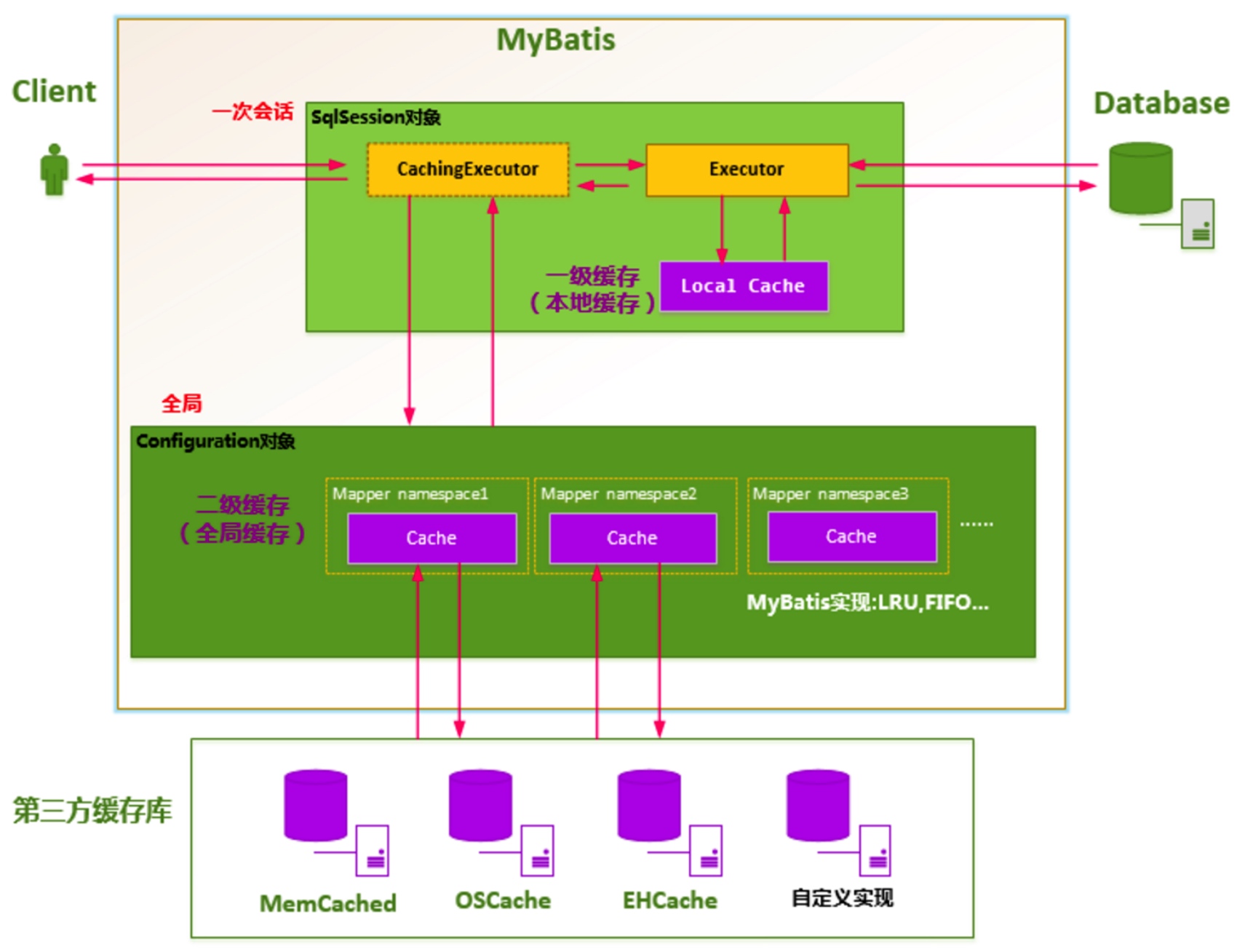一. 介绍
二级缓存使得多个SqlSession之间可以共享缓存。开启二级缓存后,会使用CachingExecutor装饰Executor。数据的查询执行的流程就是二级缓存 -> 一级缓存 -> 数据库。具体流程如图所示:
当开一个会话时,一个SqlSession对象会使用一个Executor对象来完成会话操作,MyBatis的二级缓存机制的关键就是对这个Executor对象做文章。如果用户配置了”cacheEnabled=true”,那么MyBatis在为SqlSession对象创建Executor对象时,会对Executor对象加上一个装饰者:CachingExecutor,这时SqlSession使用CachingExecutor对象来完成操作请求。CachingExecutor对于查询请求,会先判断该查询请求在Application级别的二级缓存中是否有缓存结果,如果有查询结果,则直接返回缓存结果;如果缓存中没有,再交给真正的Executor对象来完成查询操作,之后CachingExecutor会将真正Executor返回的查询结果放置到缓存中,然后在返回给用户。
CachingExecutor是Executor的装饰者,以增强Executor的功能,使其具有缓存查询的功能,这里用到了设计模式中的装饰者模式.
1.1 二级对象分类
MyBatis并不是简单地对整个Application就只有一个Cache缓存对象,它将缓存划分的更细,即是Mapper(namespace)级别的.因此二级缓存可以分为两类:
- 为每一个Mapper分配一个Cache缓存对象.(使用
节点配置) - 多个Mapper共用一个Cache缓存对象(使用
节点配置)
对于每一个Mapper.xml,如果在其中使用了
1.1.1 一个Mapper分配一个Cache()
MyBatis将Application级别的二级缓存细分到Mapper级别,即对于每一个Mapper.xml,如果在其中使用了
1.1.2 多个Mapper共用一个Cache ()
使用

1.2 如何设置
如何设置才能使Mybatis具有二级缓存功能呢?
开启MyBatis支持二级缓存的总开关:cacheEnabled=true
1
<setting name="cacheEnabled" value="true"/>
在Mapper.xml文件中,对需要支持二级缓存的select语句配置了
或 节点; - 并且该select语句的参数 useCache=true
1
2
3
4
5// StudentMapper.xml
<select id="findAllStudents" resultMap="StudentResult" useCache="true">
SELECT * FROM STUDENTS
<cache>
</select>
Mybatis对缓存的支持非常灵活,MyBatis提供了三种二级缓存的选择:
- MyBatis自身提供的缓存实现;并提供了各种缓存刷新策略如LRU,FIFO等等;
- 用户自定义的Cache接口实现;用户实现org.apache.ibatis.cache.Cache接口,然后将Cache实现类配置在
节点的type属性上即可;type中可以设置别名或者全限定名。 - 跟第三方内存缓存库的集成;
二. 二级缓存实现原理
MyBatis二级缓存的一个重要特点:即松散的Cache缓存管理和维护。一个Mapper中定义的增删改查操作只能影响到自己关联的Cache对象,不影响其他Cache对象。因此Mapper之间的缓存关系比较松散,相互关联的程度比较弱。
如果多个Mapper公共一个缓存,是否任意一个Mapper更新操作都会清空缓存呢?比如AMapper和BMapper共用一个Cache对象,AMapper和BMapper的任意的更新操作都会将共用的Cache清空,这样会频繁地清空Cache,导致Cache实际的命中率和使用率就变得很低了,所以这种策略实际情况下是不可取的。因此Mybatis采用另一套策略,当对于某些表执行了更新(update、delete、insert)操作后,不是清空所有缓存,而是清空跟这些表有关联的查询语句所造成的缓存;
MyBatis二级缓存的工作流程和前文提到的一级缓存类似,只是在一级缓存处理前,用CachingExecutor装饰了BaseExecutor的子类,在委托具体职责给delegate之前,实现了二级缓存的查询和写入功能。
2.1 数据结构
二级缓存是针对Mapper级别,对每个mapper都会创建一个缓存。MappedStatement对象存储一个mapper的所有信息,并保存在configuration中。在MappedStatement类中利用cache字段来存储缓存信息。
1 | private Cache cache; |
2.2 初始化CachingExecutor
CachingExecutor的初始化需要从sqlSession对象的创建说起,一个sqlSession对象拥有一个Executor对象。因此在创建sqlSession的同时创建Executor对象。下面是SqlSession对象的创建代码:
1 | // 创建SqlSession sqlSessionFactory是DefaultSqlSessionFactory |
SqlSession在创建过程的时候会同时创建事务和Executor:
1 | final Environment environment = configuration.getEnvironment(); |
configuration的newExecutor方法会根据缓execType类型创建不同的Excutor, 最后如果发现配置中开启了二级缓存,那么就会用装饰器CachingExecutor包装executor,具体代码如下:
1 | public Executor newExecutor(Transaction transaction, ExecutorType executorType) { |
2.3 CachingExecutor缓存获取过程
源码分析从CachingExecutor的query方法展开,在query方法主要逻辑:
- 首先会从MappedStatement中获得在配置初始化时赋予的Cache
如果Cache不为空,表示该MappedStatement开启了二级缓存设置:
- 判断是否需要刷新缓存
- 处理存储过程
- 从二级缓存中获取数据,如果存在则直接返回。
- 否则交给BaseExecutor执行,一级缓存逻辑一致。并将结果存到二级缓存中
- 否则交给BaseExecutor执行,一级缓存逻辑一致
1 | public <E> List<E> query(MappedStatement ms, Object parameterObject, RowBounds rowBounds, ResultHandler resultHandler, CacheKey key, BoundSql boundSql) |
这里有几个重要的点需要说明:
- Cache何时被设置到MappedStatement中
- flushCacheIfRequired如何刷新缓存
- TransactionalCacheManager如何获取缓存数据,即上文的tcm
2.3.1 初始化MappedStatement的Cache
XMLMapperBuilder在解析Mapper.xml文件时,如果遇到
1 | // 给定命名空间的缓存配置。 |
1 | builderAssistant.useNewCache(typeClass, evictionClass, flushInterval, size, readWrite, blocking, props); |
保存到configuration中:
1 | configuration.addCache(cache); |
1 | Cache cache = configuration.getCache(namespace); |
Mybatis内置了多个Cache实现,Cache采用了装饰类模式。以下是具体这些Cache实现类的介绍,他们的组合为Cache赋予了不同的能力:
- SynchronizedCache: 同步Cache,实现比较简单,直接使用synchronized修饰方法。
- LoggingCache: 日志功能,装饰类,用于记录缓存的命中率,如果开启了DEBUG模式,则会输出命中率日志。
- SerializedCache: 序列化功能,将值序列化后存到缓存中。该功能用于缓存返回一份实例的Copy,用于保存线程安全。
- LruCache: 采用了Lru算法的Cache实现,移除最近最少使用的key/value。
- PerpetualCache: 作为为最基础的缓存类,底层实现比较简单,直接使用了HashMap。
2.3.2 TransactionalCacheManager
MyBatis的CachingExecutor持有了TransactionalCacheManager,即上述代码中的tcm。可以理解使负责管理TransactionalCache的类。TransactionalCache是什么呢? TransactionalCache实现了Cache接口,CachingExecutor会默认使用他包装初始生成的Cache,作用是如果事务提交,对缓存的操作才会生效,如果事务回滚或者不提交事务,则不对缓存产生影响。TransactionalCache是一个事务类型的缓存实现类,用于维护二级缓存数据。因此,TransactionalCacheManager中持有了一个Map,代码如下所示:
1 | private final Map<Cache, TransactionalCache> transactionalCaches = new HashMap<Cache, TransactionalCache>(); |
这个Map保存了Cache和用TransactionalCache包装后的Cache的映射关系,通过Cache获取对应的缓存TransactionalCache。用Cache表示一个namespace对应的缓存,作为该namespace的唯一标志。而TransactionalCache是该namespace真正的缓存。
TransactionalCacheManager中有几个重要的方法:
- commit 提交
- rollback 回滚
putObject 存放到二级缓存中。首先获取获取Cache对应的TransactionalCache,然后将数据保存到TransactionalCache中:
1
2
3
4
5
6
7
8
9
10
11public void putObject(Cache cache, CacheKey key, Object value) {
getTransactionalCache(cache).putObject(key, value);
}
private TransactionalCache getTransactionalCache(Cache cache) {
TransactionalCache txCache = transactionalCaches.get(cache);
if (txCache == null) {
txCache = new TransactionalCache(cache);
transactionalCaches.put(cache, txCache);
}
return txCache;
}
getObject 获取二级缓存数据。putObject类似,首先获取TransactionalCache,然后在从TransactionalCache中根据key去查询数据。
1
2
3public Object getObject(Cache cache, CacheKey key) {
return getTransactionalCache(cache).getObject(key);
}clear 清空缓存,清空了需要在提交时加入缓存的列表,同时设定提交时清空缓存。
1
2
3public void clear(Cache cache) {
getTransactionalCache(cache).clear();
}
2.3.3 flushCacheIfRequired
在默认的设置中SELECT语句不会刷新缓存,insert/update/delte会刷新缓存。这边直接调用了TransactionalCacheManager的clear方法。
1 | private void flushCacheIfRequired(MappedStatement ms) { |
2.4 二级缓存生命周期
总计
- MyBatis的二级缓存相对于一级缓存来说,实现了SqlSession之间缓存数据的共享,同时粒度更加的细,能够到namespace级别,通过Cache接口实现类不同的组合,对Cache的可控性也更强。
- MyBatis在多表查询时,极大可能会出现脏数据,有设计上的缺陷,安全使用二级缓存的条件比较苛刻。
- 在分布式环境下,由于默认的MyBatis Cache实现都是基于本地的,分布式环境下必然会出现读取到脏数据,需要使用集中式缓存将MyBatis的Cache接口实现,有一定的开发成本,直接使用Redis,Memcached等分布式缓存可能成本更低,安全性也更高。
参考
- Mybatis 源码
- 聊聊MyBatis缓存机制 | 包含了很多验证示例,源码分析
- 终结篇:MyBatis原理深入解析(三)
- mybatis一级与二级缓存详解